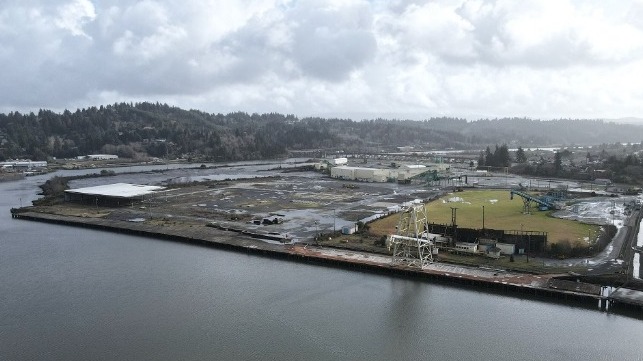Port of Coos Bay Plans to Buy a Terminal to Handle Containers

The Port of Coos Bay, Oregon has already announced long term plans to build a full-scale container terminal, but it is moving to accelerate its timetable in response to market demand. In a meeting last week, its board authorized the port to negotiate for the purchase of a former mill site, which would allow it to start receiving boxes much more quickly.
Two years ago, Georgia Pacific Corporation shuttered its lumber mill near downtown Coos Bay, cutting 111 jobs and leaving a prime piece of industrial real estate vacant. The site was purchased by Commercial Development Company, Inc. this February, and the firm suggested it might redeploy the existing dock and storage yards for shipping - potentially including containerized freight.
The mill site has not been put to a new use yet, but a sale to the port could change that quickly. Berths, storage space and intermodal rail connectivity are now in short supply on the U.S. West Coast, where the country's biggest container hubs are struggling to meet American demand for Asian goods.
If the Georgia Pacific mill is purchased and turned into a container terminal, it will not unsnarl the global supply chain on its own, but it would make a small contribution. The channel leading up to the dock has a depth of 37 feet - less than the 40 feet required for a fully-laden Panamax, but enough to accommodate a feeder or a small bulker carrying boxes. Small-vessel shipping arrangements are increasingly common as cargo owners look for novel ways to beat port congestion.
Critically, the Georgia Pacific mill is located adjacent to Coos Bay's rail line, which connects up with nationwide Class 1 rail service in Eugene. Container shippers have reported problems in using other small West Coast ports due to the shortage of trucking capacity, but Coos Bay's rail line removes that obstacle.
Over the long term, the port is planning to build out a full-size container terminal at a site closer to the harbor entrance, where there is more space and less need for dredging. That massive greenfield site will need years of permitting and development work before it is usable; by contrast, the Georgia Pacific mill site is already developed and has promise for near-term deployment.
"The port is regularly approached by companies eager to move commodities through a terminal in Coos Bay. Because the port does not currently own or operate a terminal, many of these inquiries are referred to other terminals, put on standby or turned away," said port CEO John Burns. "Acquiring property to develop a multi-model facility will create an economic boost for not only Southwest Oregon but the state of Oregon."
